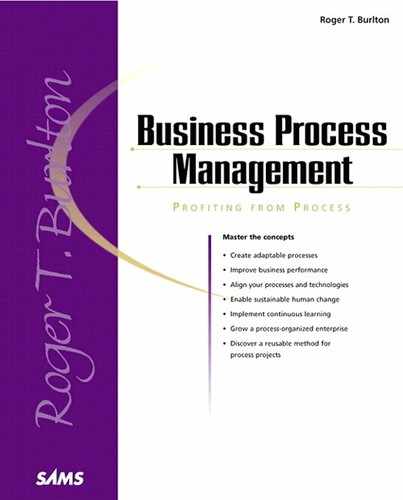Chapter 10. Discovering the Context for Business Change
|
In This Chapter |
The first two phases of the Process Management Framework—Business Context and Architect and Align—set the stage for understanding the who, what, when, where, why, and how of a business, so that the management team can prioritize, select, and complete projects throughout the remaining phases. The resulting knowledge, documents, and models produced during these phases should provide a “big picture” view of the organization segment being evaluated for renewal. This equates to the production of a roadmap for the business that should show how each piece fits with every other piece and what areas are affected by any given change project. This phase corresponds to delivering a complete owner’s view of the business. For those familiar with the Zachman framework[1] for enterprise architecture, these two phases cover row 2 (from the top in Figure 10.1).
[1] “A Framework for Information Systems Architecture,” John A. Zachman, IBM Systems Journal, vol. 26, no. 3, 1987. IBM Publication G321-5298
Figure 10.1. The Zachman Framework for Enterprise Architecture (www.zifa.com/frmwork2.htm). Reprinted with permission from John A. Zachman.

The first phase of the Process Management Framework, the Business Context phase, seeks to gain an understanding or confirm the criteria by which decisions will be made in the remaining phases and steps. Analysts examine the external pressures facing the organization and the values and principles, visionary expectations, measures of existing and targeted performance, and critical success factors from each stakeholder’s perspective, connecting them to form an overall balanced target. The results answer the questions “Why pursue business change?” and “Who cares that you do?” Taken together, these questions provide a benchmark for all future decision making. Because a common understanding of the organization and its challenges is a key deliverable, this phase is heavily oriented toward workshop and consensus management.
The Business Context phase has eight distinct steps:
1. | Validate the mission. |
2. | Analyze the business drivers. |
3. | Classify the stakeholder types. |
4. | Document current interactions and health. |
5. | Document principles and values. |
6. | Envision the future and set expectations. |
7. | Produce key performance indicators (KPIs) and targets. |
8. | Determine critical success factors. |
These steps in Figure 10.2 are shown as a sequence of logical activities to be completed. However, much work can take place in parallel, and completing one step isn’t a prerequisite for starting another. In practice, steps 1 through 3 would normally be conducted concurrently, and the organization would accept the steps 1 through 3 findings before proceeding with the remaining steps. Steps 4 through 8 can be done at the same time, and the organization can approve those results simultaneously.
Figure 10.2. Process Management Framework: Steps in the Business Context phase.

The tricks and traps presented next, and lessons learned throughout this section, should be used as guides; however, they are by no means an exhaustive list. Each organization is unlike any other, having different pressures, strengths, and weaknesses, so what might be a problem for one organization might be totally nonexistent in another. As with any business decision, sound judgment should determine how important each suggestion is to your organization. However, failing to consider the knowledge presented here will increase the risk associated with the work being performed.
Each step in the framework’s phases is described as to its intent and purpose with suggested techniques for accomplishing the step.
